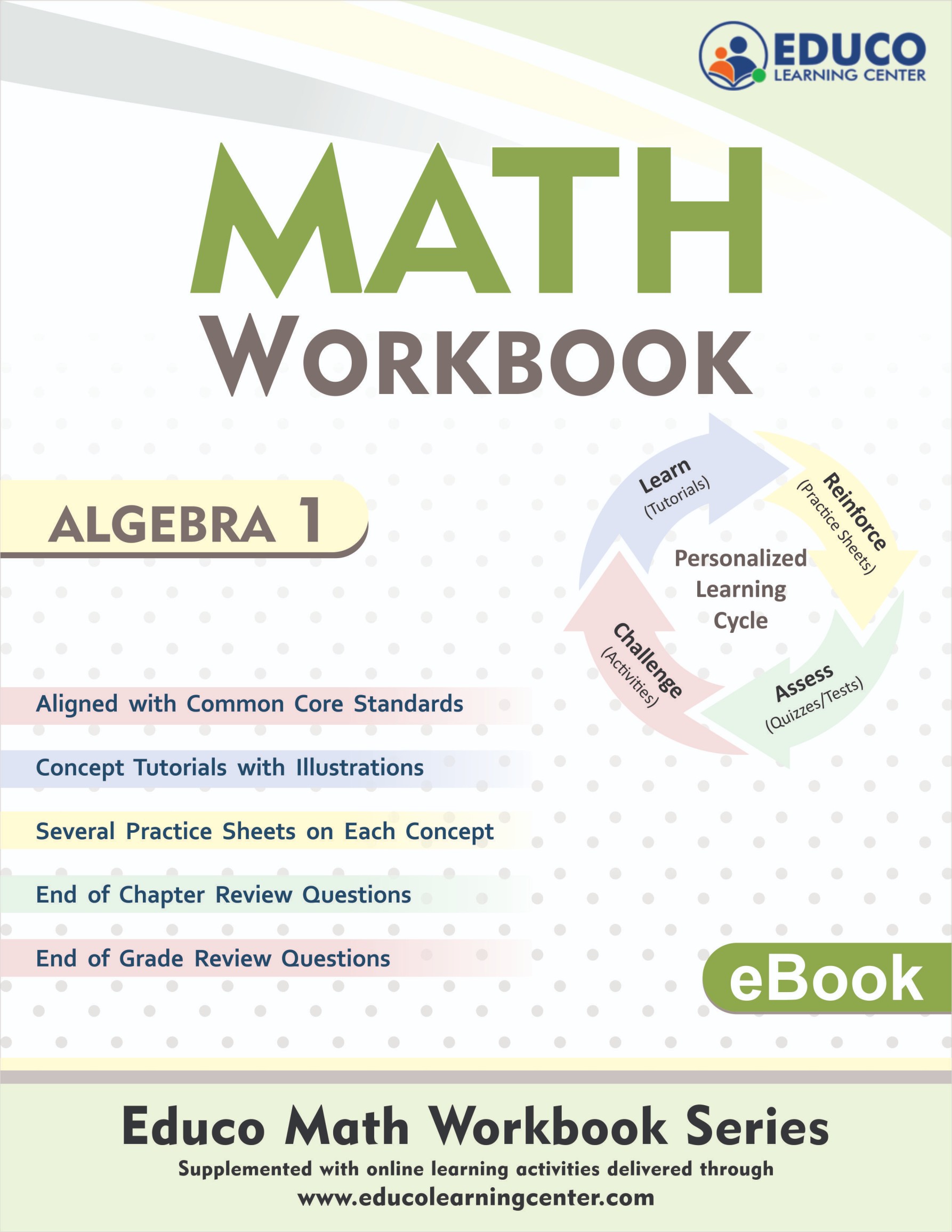Algebra 1 Course Details
Building unique learning experiences with the courses mapped to the national standards.
Course Metrics
-
 Skills
326
Skills
326 -
 Tutorials
249
Tutorials
249 -
 Video Lessons
236
Video Lessons
236 -
 Examples
1045
Examples
1045 -
 Free Response Questions
10094
Free Response Questions
10094 -
 Multiple Choice Questions
2967
Multiple Choice Questions
2967 -
 Online Practice Assessments
82
Online Practice Assessments
82 -
 Graded Assessments
84
Graded Assessments
84
Overview
The Algebra I curriculum at Educo Learning Center (ELC) focuses on essential topics aligned with the Common Core standards. Students in Algebra 1 learn to simplify and solve linear and quadratic equations and inequalities, understand and apply functions, and analyze graphs. They explore linear, quadratic, and exponential functions, focusing on their properties and applications. Additionally, students work with polynomials, rational expressions, and equations, developing skills in factoring and simplifying. The curriculum also introduces statistics and probability, enabling students to interpret data and make informed conclusions. These foundational topics align with Common Core standards and prepare students for advanced mathematics.
Educo Learning Center's interactive Algebra 1 lessons utilize dynamic graphing and guided discovery to strengthen and connect symbolic and visual reasoning. Students explore all Common Core Algebra 1 topics, including linear and quadratic equations, functions, graph analysis, polynomials, and statistics. The lessons emphasize real-world applications and provide adaptive exercises and unlimited practice tests. All work is automatically checked and graded to ensure immediate feedback and support progress.
"I Can" Statements For Math Algebra 1
Mathematics | High School—Number and Quantity
| Standard | HSNRN.A.1 |
|---|---|
| Standard Description | 1. Explain how the definition of the meaning of rational exponents follows from extending the properties of integer exponents to those values, allowing for a notation for radicals in terms of rational exponents. For example, we define 51/3 to be the cube root of 5 because we want (51/3) 3 = 5(1/3)3 to hold, so (51/3) 3 must equal 5. |
| Online Corse Hierarchy | 7.1 |
| I Can Statements | I can describe the relationship between rational exponents and radicals. |
| Standard | HSNRN.A.2 |
|---|---|
| Standard Description | 2. Rewrite expressions involving radicals and rational exponents using the properties of exponents. |
| Online Corse Hierarchy | 7.2 |
| I Can Statements | I can rewrite expressions that contain radicals and/or rational exponents using the properties of exponents. |
| Standard | HSNRN.B.3 |
|---|---|
| Standard Description | 3. Explain why the sum or product of two rational numbers is rational, that the sum of a rational number and an irrational number is irrational, and that the product of a nonzero rational number and an irrational number is irrational. |
| Online Corse Hierarchy | 1.3, 1.4 |
| I Can Statements | I can explain which operations are closed in the set of real numbers and its subsets of rational and irrational numbers. |
| Standard | HSNQ.A.1 |
|---|---|
| Standard Description | 1. Use units to understand problems and guide the solution of multi-step problems; choose and interpret units consistently in formulas; choose and interpret the scale and origin in graphs and data displays. |
| Online Corse Hierarchy | 2.3, 2.4, 4.2 |
| I Can Statements | I can choose, apply, and interpret the units for multistep problems using formulas, graphs, and other data displays. |
| Standard | HSNQ.A.2 |
|---|---|
| Standard Description | 2. Define appropriate quantities for the purpose of descriptive modeling. |
| Online Corse Hierarchy | 4.2, 5.2 |
| I Can Statements | I can analyze data to determine significant patterns (units or scales) that can result in a mathematical model. I can determine appropriate variables from data. I can determine the appropriate units and scale to model data. |
| Standard | HSNQ.A.3 |
|---|---|
| Standard Description | 3. Choose a level of accuracy appropriate to limitations on measurement when reporting quantities |
| Online Corse Hierarchy | 2.5 |
| I Can Statements | I can solve percent applications and percent errors. |
| Standard | HSNVM.C.6 |
|---|---|
| Standard Description | 6. (+) Use matrices to represent and manipulate data, e.g., to represent payoffs or incidence relationships in a network. |
| Online Corse Hierarchy | 12.1 |
| I Can Statements | I can organize data in a matrix. I can add and subtract matrices and multiply a matrix by a scalar. |
Mathematics | High School—Algebra
| Standard | HSASSE.A.1 |
|---|---|
| Standard Description | 1. Interpret expressions that represent a quantity in terms of its context. a. Interpret parts of an expression, such as terms, factors, and coefficients. b. Interpret complicated expressions by viewing one or more of their parts as a single entity. For example, interpret P(1+r)n as the product of P and a factor not depending on P |
| Online Corse Hierarchy | 1.1, 1.2, 8.2, 8.3 |
| I Can Statements | I can interpret algebraic expressions that describe real-world scenarios. This means: I can interpret the parts of an expression, including the factors, coefficients, and terms. I can use grouping strategies to interpret expressions. I can create and interpret quadratic and exponential algebraic expressions to describe real-world scenarios. |
| Standard | HSASSE.A.2 |
|---|---|
| Standard Description | 2. Use the structure of an expression to identify ways to rewrite it. For example, see x4 – y 4 as (x2 ) 2 – (y2 ) 2 , thus recognizing it as a difference of squares that can be factored as (x2 – y 2 )(x2 + y2 ). |
| Online Corse Hierarchy | 8.2, 8.3 |
| I Can Statements | I can recognize the difference of squares. I can recognize a quadratic perfect square trinomial. |
| Standard | HSASSE.B.3 |
|---|---|
| Standard Description | 3. Choose and produce an equivalent form of an expression to reveal and explain the properties of the quantity represented by the expression. a. Factor a quadratic expression to reveal the zeros of the function it defines. b. Complete the square in a quadratic expression to reveal the maximum or minimum value of the function it defines. c. Use the properties of exponents to transform expressions for exponential functions. For example, the expression 1.15t can be rewritten as (1.151/12) 12t ≈ 1.01212t to reveal the approximate equivalent monthly interest rate if the annual rate is 15%. |
| Online Corse Hierarchy | 7.4, 9.1, 9.2 |
| I Can Statements | I can determine if rewriting an expression will reveal important properties of the expression. I can factor a quadratic expression in order to reveal its zeros. I can complete the square of a quadratic expression to reveal the maximum or minimum value of the function. I can use the properties of zero and 1 to produce an equivalent form of an expression. |
| Standard | HSAAPR.A.1 |
|---|---|
| Standard Description | 1. Understand that polynomials form a system analogous to the integers; namely, they are closed under the operations of addition, subtraction, and multiplication; add, subtract, and multiply polynomials. |
| Online Corse Hierarchy | 8.1 |
| I Can Statements | I can identify a polynomial expression. I can add, subtract, and multiply polynomials. |
| Standard | HSAAPR.B.3 |
|---|---|
| Standard Description | 3. Identify zeros of polynomials when suitable factorizations are available, and use the zeros to construct a rough graph of the function defined by the polynomial. |
| Online Corse Hierarchy | 9.1 |
| I Can Statements | I can identify zeros of polynomials by factorization. |
| Standard | HSAAPR.D.6 |
|---|---|
| Standard Description | 6. Rewrite simple rational expressions in different forms; write a(x)/b(x) in the form q(x) + r(x)/b(x), where a(x), b(x), q(x), and r(x) are polynomials with the degree of r(x) less than the degree of b(x), using inspection, long division, or, for the more complicated examples, a computer algebra system. |
| Online Corse Hierarchy | 11.3 |
| I Can Statements | I can divide polynomials. |
| Standard | HSAAPR.D.7 |
|---|---|
| Standard Description | 7. (+) Understand that rational expressions form a system analogous to the rational numbers, closed under addition, subtraction, multiplication, and division by a nonzero rational expression; add, subtract, multiply, and divide rational expressions. |
| Online Corse Hierarchy | 11.1, 11.2 |
| I Can Statements | I can simplify rational expressions. I can add, subtract, multiply, and divide rational expressions |
| Standard | HSACED.A.1 |
|---|---|
| Standard Description | 1. Create equations and inequalities in one variable and use them to solve problems. Include equations arising from linear and quadratic functions and simple rational and exponential functions. |
| Online Corse Hierarchy | 1.5, 2.1, 2.4, 3.1, 3.2, 3.3, 9.1, 11.4 |
| I Can Statements | I can solve linear equations in one variable. I can solve proportions. I can solve and graph inequalities. I can solve absolute value equations and inequalities. I can solve rational equations. |
| Standard | HSACED.A.2 |
|---|---|
| Standard Description | 2. Create equations in two or more variables to represent relationships between quantities; graph equations on coordinate axes with labels and scales. |
| Online Corse Hierarchy | 4.2, 5.2, 5.3, 5.4, 5.5, 7.4, 11.5, 11.6, 9.4 |
| I Can Statements | I can write and graph equations representing relationships between variables or quantities. I can write and interpret quadratic equations and inequalities mathematically and in context, graphically and algebraically. |
| Standard | HSACED.A.3 |
|---|---|
| Standard Description | 3. Represent constraints by equations or inequalities and by systems of equations and/or inequalities, and interpret solutions as viable or non-viable options in a modeling context. For example, represent inequalities describing nutritional and cost constraints on combinations of different foods. |
| Online Corse Hierarchy | 9.5 |
| I Can Statements | I can represent constraints with linear equations, inequalities, and systems of equations or inequalities. I can determine whether solutions are viable or nonviable options, given the constraints provided in a modeling context. |
| Standard | HSACED.A.4 |
|---|---|
| Standard Description | 4. Rearrange formulas to highlight a quantity of interest, using the same reasoning as in solving equations. For example, rearrange Ohm's law. V = IR to highlight resistance R. |
| Online Corse Hierarchy | 2.2 |
| I Can Statements | I can solve formulas for a particular variable of interest. |
| Standard | HSAREI.A.1 |
|---|---|
| Standard Description | 1. Explain each step in solving a simple equation as following from the equality of numbers asserted in the previous step, starting from the assumption that the original equation has a solution. Construct a viable argument to justify a solution method. |
| Online Corse Hierarchy | 2.1 |
| I Can Statements | I can explain and justify each step for solving multi-step linear equations. |
| Standard | HSAREI.A.2 |
|---|---|
| Standard Description | 2. Solve simple rational and radical equations in one variable, and give examples showing how extraneous solutions may arise. |
| Online Corse Hierarchy | 10.2, 10.3, 11.4 |
| I Can Statements | I can solve radical equations. I can solve rational equations. |
| Standard | HSAREI.B.3 |
|---|---|
| Standard Description | 3. Solve linear equations and inequalities in one variable, including equations with coefficients represented by letters. |
| Online Corse Hierarchy | 2.1, 2.4, 3.2 |
| I Can Statements | I can solve multi-step linear equations in one variable, including equations with coefficients represented by letters. I can solve multi-step linear inequalities in one variable. |
| Standard | HSAREI.B.4 |
|---|---|
| Standard Description | 4. Solve quadratic equations in one variable. a. Use the method of completing the square to transform any quadratic equation in x into an equation of the form (x – p)2 = q with the same solutions. Derive the quadratic formula from this form. b. Solve quadratic equations by inspection (e.g., for x2 = 49), taking square roots, completing the square, the quadratic formula, and factoring as appropriate to the initial form of the equation. Recognize when the quadratic formula gives complex solutions and write them as a ± bi for real numbers a and b. |
| Online Corse Hierarchy | 9.1, 9.2, 9.3 |
| I Can Statements | I can determine whether the solution of a quadratic equation will be real or complex. I can find real solutions to quadratic equations in one variable using multiple methods and justify my solution method. |
| Standard | HSAREI.C.5 |
|---|---|
| Standard Description | 5. Prove that, given a system of two equations in two variables, replacing one equation with the sum of that equation and a multiple of the other produces a system with the same solutions. |
| Online Corse Hierarchy | 6.3 |
| I Can Statements | I can write, solve, interpret, and justify my solution method for systems of linear equations using multiple methods (linear combination, substitution, and graphing). |
| Standard | HSAREI.C.6 |
|---|---|
| Standard Description | 6. Solve systems of linear equations exactly and approximately (e.g., with graphs), focusing on pairs of linear equations in two variables. |
| Online Corse Hierarchy | 6.1, 6.2, 6.3, 6.4 |
| I Can Statements | I can solve systems of linear equations using multiple methods (linear combination, substitution, and graphing). |
| Standard | HSAREI.C.7 |
|---|---|
| Standard Description | 7. Solve a simple system consisting of a linear and quadratic equation in two variables, algebraically and graphically. For example, find the points of intersection between the line y = –3x and the circle x 2 + y2 = 3. |
| Online Corse Hierarchy | 9.5 |
| I Can Statements | I can solve a system of equations consisting of linear and quadratic equations algebraically and graphically. |
| Standard | HSAREI.D.10 |
|---|---|
| Standard Description | 10. Understand that the graph of an equation in two variables is the set of all its solutions plotted in the coordinate plane, often forming a curve (which could be a line). |
| Online Corse Hierarchy | 1.6, 4.1, 4.2 |
| I Can Statements | I can describe and interpret the solution set of a system of equations graphically and relate that to the algebraic solution. |
| Standard | HSAREI.D.11 |
|---|---|
| Standard Description | 11. Explain why the x-coordinates of the points where the graphs of the equations y = f(x) and y = g(x) intersect are the solutions of the equation f(x) = g(x); find the solutions approximately, e.g., using technology to graph the functions, make tables of values, or find successive approximations. Include cases where f(x) and/or g(x) are linear, polynomial, rational, absolute value, exponential, and logarithmic functions. |
| Online Corse Hierarchy | 9.5 |
| I Can Statements | I can solve a system of linear and quadratic equations. |
| Standard | HSAREI.D.12 |
|---|---|
| Standard Description | 12. Graph the solutions to a linear inequality in two variables as a half-plane (excluding the boundary in the case of a strict inequality), and graph the solution set to a system of linear inequalities in two variables as the intersection of the corresponding half-planes. |
| Online Corse Hierarchy | 6.5 |
| I Can Statements | I can describe and interpret the solutions to a system of linear inequalities graphically. |
| Standard | HSAREI.A.1 |
|---|---|
| Standard Description | 1. Explain each step in solving a simple equation as following from the equality of numbers asserted in the previous step, starting from the assumption that the original equation has a solution. Construct a viable argument to justify a solution method. |
| Online Corse Hierarchy | 2.1 |
| I Can Statements | I can explain and justify each step for solving multi-step linear equations. |
| Standard | HSAREI.A.2 |
|---|---|
| Standard Description | 2. Solve simple rational and radical equations in one variable, and give examples showing how extraneous solutions may arise. |
| Online Corse Hierarchy | 10.2, 10.3, 11.4 |
| I Can Statements | I can solve radical equations. I can solve rational equations. |
| Standard | HSAREI.B.3 |
|---|---|
| Standard Description | 3. Solve linear equations and inequalities in one variable, including equations with coefficients represented by letters. |
| Online Corse Hierarchy | 2.1, 2.4, 3.2 |
| I Can Statements | I can solve multi-step linear equations in one variable, including equations with coefficients represented by letters. I can solve multi-step linear inequalities in one variable. |
| Standard | HSAREI.B.4 |
|---|---|
| Standard Description | 4. Solve quadratic equations in one variable. a. Use the method of completing the square to transform any quadratic equation in x into an equation of the form (x – p)2 = q with the same solutions. Derive the quadratic formula from this form. b. Solve quadratic equations by inspection (e.g., for x2 = 49), taking square roots, completing the square, the quadratic formula, and factoring as appropriate to the initial form of the equation. Recognize when the quadratic formula gives complex solutions and write them as a ± bi for real numbers a and b. |
| Online Corse Hierarchy | 9.1, 9.2, 9.3 |
| I Can Statements | I can determine whether the solution of a quadratic equation will be real or complex. I can find real solutions to quadratic equations in one variable using multiple methods and justify my solution method. |
Mathematics | High School—Functions
| Standard | HSFIF.A.1 |
|---|---|
| Standard Description | 1. Understand that a function from one set (called the domain) to another set (called the range) assigns to each element of the domain exactly one element of the range. If f is a function and x is an element of its domain, then f(x) denotes the output of f corresponding to the input x. The graph of f is the graph of the equation y = f(x). |
| Online Corse Hierarchy | 4.3 |
| I Can Statements | I can determine if a relation is a function. I can represent a function using a graph, table, and equation and describe the relationship between each form using function notation. |
| Standard | HSFIF.A.2 |
|---|---|
| Standard Description | 2. Use function notation, evaluate functions for inputs in their domains, and interpret statements that use function notation in terms of context. |
| Online Corse Hierarchy | 4.3 |
| I Can Statements | I can evaluate a function using function notation and interpret the value in context. I can determine the domain and range of a function. |
| Standard | HSFIF.A.3 |
|---|---|
| Standard Description | 3. Recognize that sequences are functions, sometimes defined recursively, whose domain is a subset of the integers. For example, the Fibonacci sequence is defined recursively by f(0) = f(1) = 1, f(n+1) = f(n) + f(n-1) for n ≥ 1. |
| Online Corse Hierarchy | 4.4 |
| I Can Statements | I can recognize that sequences are functions. I can define arithmetic sequences. |
| Standard | HSFIF.B.4 |
|---|---|
| Standard Description | 4. For a function that models a relationship between two quantities, interpret key features of graphs and tables in terms of the quantities and sketch graphs showing key features given a verbal description of the relationship. Key features include intercepts, intervals where the function is increasing, decreasing, positive, or negative; relative maximums and minimums; symmetries; end behavior; and periodicity. |
| Online Corse Hierarchy | 4.2, 5.3, 5.4, 5.5, 7.3, 9.4, 11.6 |
| I Can Statements | I can interpret the graphical representation of linear and exponential functions. This means: I can identify and interpret an appropriate domain and range. I can interpret key elements of the graph, including the average rate of change, y-intercept, x-intercepts. I can sketch a graph showing key features given a particular scenario or context. |
| Standard | HSFIF.B.5 |
|---|---|
| Standard Description | 5. Relate the domain of a function to its graph and, where applicable, to the quantitative relationship it describes. For example, if the function h(n) gives the number of person-hours it takes to assemble n engines in a factory, then the positive integers would be an appropriate domain for the function. |
| Online Corse Hierarchy | 4.2, 7.3, 9.4, 11.5 |
| I Can Statements | I can determine the appropriate domain of a function |
| Standard | HSFIF.B.6 |
|---|---|
| Standard Description | 6. Calculate and interpret a function's average rate of change (presented symbolically or as a table) over a specified interval. Estimate the rate of change from a graph. |
| Online Corse Hierarchy | 5.1 |
| I Can Statements | I can calculate and interpret the rate of change of a function. I can estimate the rate of change over a given interval from a graph. |
| Standard | HSFIF.C.7 |
|---|---|
| Standard Description | 7. Graph functions expressed symbolically and show key features of the graph by hand in simple cases and using technology for more complicated cases. a. graph linear and quadratic functions and show intercepts, maxima, and minima. b. Graph square root, cube root, and piecewise-defined functions, including step functions and absolute value functions. c. Graph polynomial functions, identifying zeros when suitable factorizations are available and showing end behavior. d. (+) Graph rational functions, identifying zeros and asymptotes when suitable factorizations are available and showing end behavior. e. graph exponential and logarithmic functions, showing intercepts and end behavior, and trigonometric functions, showing period, midline, and amplitude. |
| Online Corse Hierarchy | 5.3, 5.4, 5.5, 5.7, 7.3, 9.4, 10.4 |
| I Can Statements | I can graph linear, exponential, and quadratic functions that are expressed symbolically. This means: I can show intercepts, maxima, and minima. I can graph square root and cube root functions. I can graph piecewise-defined functions, including step functions and absolute value functions. I can graph polynomial functions. I can graph rational functions. I can graph exponential functions. |
| Standard | HSFIF.C.8 |
|---|---|
| Standard Description | 8. Write a function defined by an expression in different but equivalent forms to reveal and explain the different properties of the function. a. Use the process of factoring and completing the square in a quadratic function to show the graph's zeros, extreme values, and symmetry and interpret these in terms of context. b. Use the properties of exponents to interpret expressions for exponential functions. For example, identify the percent rate of change in functions such as y = (1.02)t , y = (0.97)t , y = (1.01)12t, y = (1.2)t/10, and classify them as representing exponential growth or decay. |
| Online Corse Hierarchy | 7.4, 9.1, 9.4 |
| I Can Statements | I can factor to find the zeros of a quadratic function. I can complete the square to show extreme values and symmetry. I can interpret important points on a quadratic graph in terms of context. I can model exponential growth and decay. |
| Standard | HSFIF.C.9 |
|---|---|
| Standard Description | 9. Compare properties of two functions, each represented in a different way (algebraically, graphically, numerically in tables, or by verbal descriptions). For example, given a graph of one quadratic function and an algebraic expression for another, say which has the larger maximum. |
| Online Corse Hierarchy | 7.3, 9.4 |
| I Can Statements | I can compare two functions that are each represented differently (graphs, tables, equations, verbal descriptions) and draw conclusions based on those comparisons. |
| Standard | HSFBF.A.1 |
|---|---|
| Standard Description | 1. Write a function that describes a relationship between two quantities. a. Determine an explicit expression, a recursive process, or steps for calculation from a context. |
| Online Corse Hierarchy | 7.5 |
| I Can Statements | I can write and use recursive formulas for geometric sequences. |
| Standard | HSFBF.A.2 |
|---|---|
| Standard Description | 2. Write recursively and with an explicit formula, use arithmetic and geometric sequences to model situations, and translate between the two forms. |
| Online Corse Hierarchy | 7.5 |
| I Can Statements | I can explain that sequences are functions and are sometimes defined recursively. |
| Standard | HSFBF.B.3 |
|---|---|
| Standard Description | 3. Identify the effect on the graph of replacing f(x) by f(x) + k, k f(x), f(kx), and f(x + k) for specific values of k (both positive and negative); find the value of k given the graphs. Experiment with cases and illustrate an explanation of the effects on the graph using technology. Include recognizing even and odd functions from their graphs and their algebraic expressions. |
| Online Corse Hierarchy | 5.7, 9.4 |
| I Can Statements | I can determine the effect of a transformational constant on a linear function I can describe how a quadratic function can be transformed using a constant, k. This means: I can experiment with different transformational constants and construct an argument about their effect on a quadratic function using technology. I can determine the transformational constant from the graph of a quadratic (shifts and stretches, both vertical and horizontal). |
| Standard | HSFLE.A.1 |
|---|---|
| Standard Description | 1. Distinguish between situations that can be modeled with linear functions and with exponential functions. a. Prove that linear functions grow by equal differences over equal intervals and that exponential functions grow by equal factors over equal intervals. b. Recognize situations in which one quantity changes at a constant rate per unit interval relative to another. c. Recognize situations in which a quantity grows or decays by a constant percent rate per unit interval relative to another. |
| Online Corse Hierarchy | 5.1, 7.4 |
| I Can Statements | I can analyze a given context to determine whether it can be modeled with a linear or an exponential function. |
| Standard | HSFLE.A.2 |
|---|---|
| Standard Description | 2. Construct linear and exponential functions, including arithmetic and geometric sequences, given a graph, a description of a relationship, or two input-output pairs (include reading these from a table). |
| Online Corse Hierarchy | 5.3, 5.4, 5.5, 7.5 |
| I Can Statements | I can construct different forms of linear functions given a graph, a description of a relationship, or two inputoutput pairs (including reading these from a table). I can analyze an arithmetic or geometric sequence to determine a corresponding linear or exponential function. |
| Standard | HSFLE.B.5 |
|---|---|
| Standard Description | 5. Interpret the parameters in a linear or exponential function in terms of context. |
| Online Corse Hierarchy | 5.4, 5.5, 7.4 |
| I Can Statements | I can interpret the parameters in linear and exponential function models in terms of their contexts. |
Mathematics | High School—Geometry
| Standard | HSGSRT.C.6 |
|---|---|
| Standard Description | 6. Understand that by similarity, side ratios in right triangles are properties of the angles in the triangle, leading to definitions of trigonometric ratios for acute angles. |
| Online Corse Hierarchy | 10.5 |
| I Can Statements | I can find and use trigonometric ratios. |
| Standard | HSGSRT.C.8 |
|---|---|
| Standard Description | 8. Use trigonometric ratios and the Pythagorean Theorem to solve right triangles in applied problems. |
| Online Corse Hierarchy | 10.1, 10.5 |
| I Can Statements | I can solve problems using the Pythagoras Theorem. I can identify right triangles. |
| Standard | HSGGPE.B.5 |
|---|---|
| Standard Description | 5. Prove the slope criteria for parallel and perpendicular lines and use them to solve geometric problems (e.g., find the equation of a line parallel or perpendicular to a given line that passes through a given point). |
| Online Corse Hierarchy | 5.6 |
| I Can Statements | I can find slopes of parallel and perpendicular lines. I can find the equation of a line parallel or perpendicular to the given line. |
Mathematics | High School—Statistics and Probability
| Standard | HSSID.A.1 |
|---|---|
| Standard Description | 1. Represent data with plots on the real number line (dot plots, histograms, and box plots). |
| Online Corse Hierarchy | 12.2 |
| I Can Statements | I can represent data with dot plots, histograms, and box plots. |
| Standard | HSSID.A.2 |
|---|---|
| Standard Description | 2. Use statistics appropriate to the shape of the data distribution to compare the center (median, mean) and spread (interquartile range, standard deviation) of two or more different data sets. |
| Online Corse Hierarchy | 12.3, 12.4 |
| I Can Statements | I can compare the center (mean and median) and spread (interquartile range and standard deviation) of two or more data sets based on the shape of the data distribution. |
| Standard | HSSID.A.3 |
|---|---|
| Standard Description | 3. Interpret differences in shape, center, and spread in the context of the data sets, accounting for possible effects of extreme data points (outliers). |
| Online Corse Hierarchy | 12.3, 12.4 |
| I Can Statements | I can interpret differences in shape, center, and spread based on the context of the data set and determine possible effects of outliers on these measures. |
| Standard | HSSID.B.5 |
|---|---|
| Standard Description | 5. Summarize categorical data for two categories in two-way frequency tables. Interpret relative frequencies in the context of the data (including joint, marginal, and conditional relative frequencies). Recognize possible associations and trends in the data. |
| Online Corse Hierarchy | 12.6 |
| I Can Statements | I can create a two-way frequency table. I can interpret relative frequencies given the context of the data. I can recognize possible associations and trends in the data. |
| Standard | HSSID.B.6 |
|---|---|
| Standard Description | 6. Represent data on two quantitative variables on a scatter plot, and describe how the variables are related. a. Fit a function to the data; use functions fitted to data to solve problems in the context of the data. Use given functions or choose a function suggested by the context. Emphasize linear, quadratic, and exponential models. b. Informally assess the fit of a function by plotting and analyzing residuals. c. Fit a linear function for a scatter plot that suggests a linear association. |
| Online Corse Hierarchy | 12.6 |
| I Can Statements | I can show two variable data on a scatter plot. I can describe the relationship between the variables. I can identify a function of best fit for the data set. I can assess the fit of a function to a data set. |
| Standard | HSSID.C.7 |
|---|---|
| Standard Description | 7. Interpret the slope (rate of change) and the intercept (constant term) of a linear model in the context of the data. |
| Online Corse Hierarchy | 12.6 |
| I Can Statements | I can interpret the slope and intercept of a linear model based on context. |
| Standard | HSSID.C.8 |
|---|---|
| Standard Description | 8. Compute (using technology) and interpret the correlation coefficient of a linear fit. |
| Online Corse Hierarchy | 12.6 |
| I Can Statements | I can compute and interpret the correlation coefficient of a linear fit. |
| Standard | HSSID.C.9 |
|---|---|
| Standard Description | 9. Distinguish between correlation and causation. |
| Online Corse Hierarchy | 12.6 |
| I Can Statements | I can describe the difference between correlation and causation. |
| Standard | HSSIC.B.3 |
|---|---|
| Standard Description | 3. Recognize the purposes of and differences among sample surveys, experiments, and observational studies; explain how randomization relates to each. |
| Online Corse Hierarchy | 12.5 |
| I Can Statements | I can classify data and analyze samples and surveys. |
| Standard | HSSCP.A.1 |
|---|---|
| Standard Description | 1. Describe events as subsets of a sample space (the set of outcomes) using characteristics (or categories) of the outcomes, or as unions, intersections, or complements of other events (“or,” “and,” “not”). |
| Online Corse Hierarchy | 12.8 |
| I Can Statements | I can find theoretical and experimental probabilities. |
| Standard | HSSCP.A.2 |
|---|---|
| Standard Description | 2. Understand that two events A and B are independent if the probability of A and B occurring together is the product of their probabilities, and use this characterization to determine if they are independent. |
| Online Corse Hierarchy | 12.9 |
| I Can Statements | I can understand independent events. |
| Standard | HSSCP.B.7 |
|---|---|
| Standard Description | 7. Apply the Addition Rule, P(A or B) = P(A) + P(B) – P(A and B), and interpret the answer in terms of the model. |
| Online Corse Hierarchy | 12.9 |
| I Can Statements | I can find probabilities of mutually exclusive and overlapping events. I can find probabilities of independent and dependent events using the addition rule. |
| Standard | HSSCP.B.9 |
|---|---|
| Standard Description | 9. (+) Use permutations and combinations to compute probabilities of compound events and solve problems. |
| Online Corse Hierarchy | 12.7 |
| I Can Statements | I can use permutations and combinations to compute probabilities. |
Features
| The ELC platform integrates well-known children's learning pedagogies with standardaligned courses for grades 1 to 12. It features an easy-to-use workflow for learning, practicing, and assessing student performance | ||||||||||||||||||||||||||||||||||||||||||||||||||||||||||||||||||||||||||||||||||||||||||||||||||
| Student features for Learning and Parent features for Monitoring and Support | ||||||||||||||||||||||||||||||||||||||||||||||||||||||||||||||||||||||||||||||||||||||||||||||||||
|
||||||||||||||||||||||||||||||||||||||||||||||||||||||||||||||||||||||||||||||||||||||||||||||||||
E-Workbook

Algebra 1
 Number of Pages: 467
Number of Pages: 467
 Printable Version
Printable Version
Inside the e-Workbook
| CHAPTER 1:
Foundations for Algebra |
Variables and Expressions
Order of Operations and Evaluating Expressions Real Number System Operations on Real Numbers An Introduction to Equations Linear Equations in Two Variables |
| CHAPTER 2:
Solving Equations in One Variable |
Solving Equations in One Variable
Literal Equations and Formulas Ratios, Rates and Conversions Solving Proportions and Similar Figures, Scale Drawings Percent Applications |
| CHAPTER 3:
Solving Inequalities in One Variable |
Sets and Operations
Solve and Graph Inequalities Absolute Value Equations and Inequalities |
| CHAPTER 4:
Introduction to Functions |
Patterns and Linear/Non-Linear Functions
Graphing and Writing a Function Rule Formalizing Relations and Functions Arithmetic Sequences |
| CHAPTER 5:
Linear Functions |
Rate of Change and Slope
Direct Variations Slope Intercept Form of Equation of a Line Point-Slope Form of Equation of a Line Standard Form of Equation of a Line Parallel and Perpendicular Lines Graphing Absolute Values Functions |
| CHAPTER 6:
System of Equations and Inequalities |
Solving Systems by Graphing
Solving Systems Using Substitution Solving Systems Using Elimination Applications of Linear Systems Linear Inequalities and Systems of Linear Inequalities |
| CHAPTER 7:
Exponents and Exponential Functions |
Exponents and Rules of Exponents
Rational Exponents Exponential Functions Exponential Growth and Decay Geometric Sequences |
| CHAPTER 8:
Operations on Polynomials |
Operations on Polynomials
GCF and Factoring Polynomials Factoring Special Cases |
| CHAPTER 9:
Quadratic Functions and Equations |
Solving Quadratic Equations Using Square Root Property and Factoring
Solve by Completing Squares The Quadratic Formula and the Discriminant Graphing Quadratic Functions System of Linear and Quadratic Equations |
| CHAPTER 10:
Radical Expressions and Equations |
The Pythagorean Theorem
Radical Expressions, Simplify, Add and Subtract Solving Radical Equations Graphing Square Root Functions Trigonometric Ratios |
| CHAPTER 11:
Rational Expressions and Equations |
Simplifying Rational Expressions
Operations on Rational Expressions Dividing Polynomials Solving Rational Equations Inverse Variation Graphing Rational Functions |
| CHAPTER 12:
Data Analysis and Probability |
Organizing Data Using Matrices
Frequency and Histograms Measures of Central Tendency and Dispersion Box-and-Whisker Plot Samples and Surveys Scatter Plots and Trend Lines Permutations and Combinations Theoretical and Experimental Probability Probability of Compound Events |
Common Core Standards


ELC courses cover 100% of skills defined in Common Core Math Standards for Algebra 1. In addition to CCSS skills, our Algebra 1 course covers essential pre-requisites skills from previous grades for review and more advanced skills for students who want to get ahead.


How to read the grade level standards?
Algebra 1 Domains Summary:
| Code | Conceptual Category | Domains | Topics |
|---|---|---|---|
| HSN | Number and Quantity | The Real Number System N-RN |
|
| Quantities N-Q |
|
||
| Vector and Matrix Quantities N-VM |
|
||
| HSA | Algebra | Seeing Structure in Expressions A-SSE |
|
| Arithmetic with Polynomials and Rational Expressions A-APR |
|
||
| Creating Equations A-CED |
|
||
| Reasoning with Equations and Inequalities A-REI |
|
||
| HSF | Functions | Interpreting Functions F-IF |
|
| Building Functions F-BF |
|
||
| Linear and Exponential Models F-LE |
|
||
| HSG | Geometry | Similarity, Right Triangles, and Trigonometry G-SRT |
|
| Expressing Geometric Properties with Equations G-GPE |
|
||
| HSS | Statistics and Probability | Interpreting Categorical and Quantitative Data S-ID |
|
| Making Inferences and Justifying Conclusions S-IC |
|
||
| Conditional Probability and the Rules of Probability S-CP |
|
The following table summarizes what Math domains are covered in K-12 grades:
| Domains | Code | Grades |
|---|---|---|
| Counting & Cardinality | CC | K |
| Operations & Algebraic Thinking | OA | K,1,2,3,4,5 |
| Number & Operations in Base 10 | NBT | K,1,2,3,4,5 |
| NUMBER & Operations - Fractions | NF | K,1,2,3,4,5 |
| Measurement & Data | MD | K,1,2,3,4,5 |
| Geometry | G | K,1,2,3,4,5,6,7,8 |
| Ratio & Proportional Relationships | RP | 6,7 |
| Number System | NS | 6,7,8 |
| Expressions & Equations | EE | 6.7.8 |
| Functions | F | 8 |
| Statistics & Probability | SP | 6-7-8, |
| Number & Quantity | HSN | 9-12 |
| Algebra | HAS | 9-12 |
| Functions | HSF | 9-12 |
| Modeling | HSM | 9-12 |
| Geometry | HSG | 9-12 |
| Statistics & Probability | HSS | 9-12 |
Click here to discover the comprehensive Common Core State Standards.